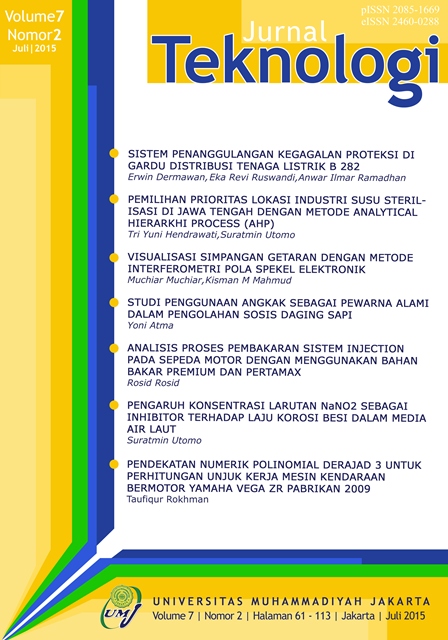PENGARUH KONSENTRASI LARUTAN NaNO2 SEBAGAI INHIBITOR TERHADAP LAJU KOROSI BESI DALAM MEDIA AIR LAUT
Main Article Content
Abstract
Downloads
Article Details
COPYRIGHT POLICY
The author(s) of an article published in the Jurnal Teknologi retains ownership of the intellectual property rights in work (s).
PUBLISHING RIGHTS
The author(s) of an article published in the Jurnal Teknologi have unrestricted publication rights. The authors give the Jurnal Teknologi the right to publish the article and designate the Faculty of Engineering Universitas Muhammadiyah Jakarta Publishing as the original publisher of the article.
LICENSING POLICY
Journal of Mechanical Engineering and Sciences is an open-access journal that follows the Creative Commons Non-Commercial 4.0 International License (CC BY-NC 4.0), which states that:

Under this license, the reusers must give appropriate credit, provide a link to the license, and indicate if changes were made. Users may do so in any reasonable manner, but not in any way that suggests the licensor endorses users or their use.
Please take the time to read the whole license agreement (https://creativecommons.org/licenses/by-nc/4.0/). As long as reusers follow the license conditions, the owner cannot withdraw these freedoms. The following components are included under this license:
 Attribution: Users must provide appropriate attribution, including a link to the license, and indicate whether or not they made any modifications. Users are free to do so reasonably, but not in a manner that indicates the licensee approves of their usage.
Attribution: Users must provide appropriate attribution, including a link to the license, and indicate whether or not they made any modifications. Users are free to do so reasonably, but not in a manner that indicates the licensee approves of their usage.
 NonCommercial: Users may not use the material for commercial purposes.
NonCommercial: Users may not use the material for commercial purposes.
References
Widharto, Sri, Karat dan Pencegahannya, Pradnya Paramita, Jakarta 1999.
Jones, Denny, Principles and Prevention of Corrosion, MacMillan Publishing Company, New York 1922
Marcus, Philippe, Corrosion Mechanisms in Theory and Practice, Marcel Dekker Inc., Paris 2002.
Fontana, G, Corrosion Engineering, McGraw-Hill Book Company, New York 1986
Dalimunthe, Indra Surya, Kimia dari Inhibitor Korosi, Prodi Teknik Kimia, Universitas Sumatera Utara, 2004
J. Chamberlain and K.R. Trethewey, Korosi untuk Mahasiswa dan Rekayasawan, PT. Gramedia Pustaka Utama, Jakarta 1991.
Scumacher, M., Seawater Corrosion Handbook, Noyes Data Corp, New York 1999.
Manganon, Pat L., The Principles of Material Selection for Engineering Design, Prentice Hall, Florida 1999.
Revie, R. Winston, Uhlig’s Corrosion Handbook 2nd ed, John Willey & Sons Inc., New York 2000.
Zuas, Oman, Inhibisi Korosi besi dengan inhibitor Natium Nitrit dalam air laut pengaruh konsentrasi dan pH, Jurnal Widyariset, Vol. 4 tahun 2000.
Laque, Francis L., Marine Corrosion, John Willey & Sons Inc. Kanada 1975.
ASTM Handbook, Corrosion: Fundamentals, Testing and Protection, Vol. 3,
USA: ASTM International 2003.
ASTM International, ASTM G31-72: Standar Practice for Laboratory Immersion Corrosion of Metals, USA 2004.
Roberge, Piere R, Handbook of Corrosion Engineering, McGraw-Hill, New York 2000.

